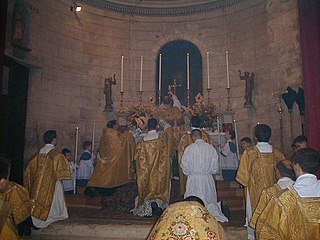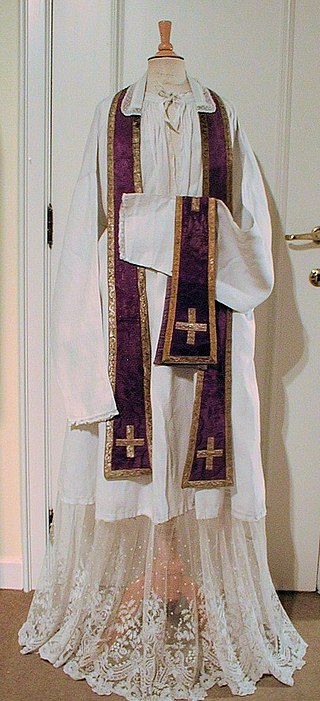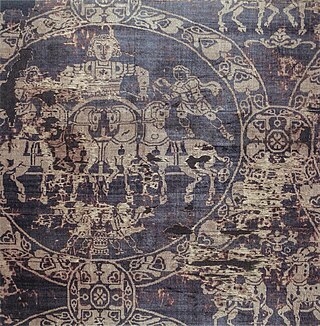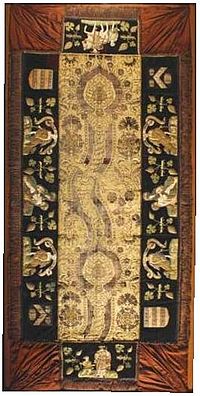
A funeral is a ceremony connected with the final disposition of a corpse, such as a burial or cremation, with the attendant observances. Funerary customs comprise the complex of beliefs and practices used by a culture to remember and respect the dead, from interment, to various monuments, prayers, and rituals undertaken in their honour. Customs vary between cultures and religious groups. Funerals have both normative and legal components. Common secular motivations for funerals include mourning the deceased, celebrating their life, and offering support and sympathy to the bereaved; additionally, funerals may have religious aspects that are intended to help the soul of the deceased reach the afterlife, resurrection or reincarnation.

A mantle is an ecclesiastical garment in the form of a very full cape that extends to the floor, joined at the neck, that is worn over the outer garments. Especially in the case of Elijah, it was likely a tallit, a Hebrew garment that housed the fringes still seen today which are also translated at “the hem of His garment” in the New Testament. It is also likely that further ecclesiastical garments were based originally on this one.

Liturgical colours are specific colours used for vestments and hangings within the context of Christian liturgy. The symbolism of violet, blue, white, green, red, gold, black, rose and other colours may serve to underline moods appropriate to a season of the liturgical year or may highlight a special occasion.

Mourning is the expression of an experience that is the consequence of an event in life involving loss, causing grief, occurring as a result of someone's death, specifically someone who was loved, although loss from death is not exclusively the cause of all experience of grief.

A coffin is a funerary box used for viewing or keeping a corpse, either for burial or cremation.

Vestments are liturgical garments and articles associated primarily with the Christian religion, especially by Eastern Churches, Catholics, Lutherans, and Anglicans. Many other groups also make use of liturgical garments; among the Reformed (Calvinist) Churches this was a point of controversy in the Protestant Reformation and sometimes since, in particular during the ritualist controversies in the Church of England in the 19th century.

The stole is a liturgical vestment of various Christian denominations, which symbolizes priestly authority; in Protestant denominations which do not have priests but use stoles as a liturgical vestment, however, it symbolizes being a member of the ordained. It consists of a band of colored cloth, usually of silk, about seven and a half to nine feet long and three to four inches wide, whose ends may be straight or may broaden out in the shape of a spade or bell. The center of the stole is worn around the back of the neck and the two ends hang down parallel to each other in front, either attached to each other or hanging loose. The stole is almost always decorated in some way, usually with two crosses, or sometimes another significant religious design. It is often decorated with contrasting galloons and fringe is usually applied to the ends of the stole following Numbers 15:38–39. A piece of white linen or lace may be stitched onto the back of the collar as a sweat guard, which can be replaced more cheaply than the stole itself.

The chasuble is the outermost liturgical vestment worn by clergy for the celebration of the Eucharist in Western-tradition Christian churches that use full vestments, primarily in Roman Catholic, Anglican, and Lutheran churches. In the Eastern Orthodox Churches and in the Eastern Catholic Churches, the equivalent vestment is the phelonion.

The cincture is a rope-like or ribbon-like article sometimes worn with certain Christian liturgical vestments, encircling the body around or above the waist. As usual with vestments, both the term and the object are taken from ordinary everyday dress of the distant past. There are two types of cinctures: one is a rope-like narrow girdle or rope-like belt around the waist. The other type is a broad ribbon of cloth that runs around the waist and usually has a section that hangs down from the waist; this type is often called a "band cincture" - it would be a "waist-sash" in secular contexts. One or both types are often used in various Christian denominations. Both types are used in the various Western rites of the Catholic Church and provinces of the Anglican Communion. Consecrated members of the various Eastern rites, whether in the Catholic Church, or in the various Orthodox communions, sometimes wear a belt referred to as a zone.

The mitre or miter is a type of headgear now known as the traditional, ceremonial headdress of bishops and certain abbots in traditional Christianity. Mitres are worn in the Catholic Church, Eastern Orthodox Church, Oriental Orthodox Churches, the Anglican Communion, some Lutheran churches, for important ceremonies, by the Metropolitan of the Malankara Mar Thoma Syrian Church, and also, in the Catholic Church, all cardinals, whether or not bishops, and some Eastern Orthodox archpriests.

The cope is a liturgical vestment, more precisely a long mantle or cloak, open in front and fastened at the breast with a band or clasp. It may be of any liturgical colour.

Shroud usually refers to an item, such as a cloth, that covers or protects some other object. The term is most often used in reference to burial sheets, mound shroud, grave clothes, winding-cloths or winding-sheets, such as the famous Shroud of Turin, tachrichim that Jews are dressed in for burial, or the white cotton kaffan sheets Muslims are wrapped in for burial.

A military funeral is a memorial or burial rite given by a country's military for a soldier, sailor, marine or airman who died in battle, a veteran, or other prominent military figures or heads of state. A military funeral may feature guards of honor, the firing of volley shots as a salute, drumming and other military elements, with a flag draping over the coffin.

A pallbearer is one of several participants who help carry the casket at a funeral. They may wear white gloves in order to prevent damaging the casket and to show respect to the deceased person.
Clerical clothing is non-liturgical clothing worn exclusively by clergy. It is distinct from vestments in that it is not reserved specifically for use in the liturgy. Practices vary: clerical clothing is sometimes worn under vestments, and sometimes as the everyday clothing or street wear of a priest, minister, or other clergy member. In some cases, it can be similar or identical to the habit of a monk or nun.

An altar cloth is used in the Christian liturgy to cover the altar. It serves as a sign of reverence as well as a decoration and a protection of the altar and the sacred vessels. In the orthodox churches it is covered by the antimension, which also contains the relics of saints.

A religious habit is a distinctive set of religious clothing worn by members of a religious order. Traditionally some plain garb recognizable as a religious habit has also been worn by those leading the religious eremitic and anchoritic life, although in their case without conformity to a particular uniform style.

A Christian burial is the burial of a deceased person with specifically Christian rites; typically, in consecrated ground. Until recent times Christians generally objected to cremation because it interfered with the concept of the resurrection of a corpse, and practiced inhumation almost exclusively. Today this opposition has all but vanished among Protestants and Catholics alike, and this is rapidly becoming more common, although Eastern Orthodox Churches still mostly forbid cremation.

An antependium, also known as a pulpit fall, parament or hanging, or, when speaking specifically of the hanging for the altar, an altar frontal, is a decorative piece, usually of textile, but also metalwork, stone or other material that can adorn a Christian altar.

The Epitaphios is a Christian religious icon, typically consisting of a large, embroidered and often richly adorned cloth, bearing an image of the dead body of Christ, often accompanied by his mother and other figures, following the Gospel account. It is used during the liturgical services of Good Friday and Holy Saturday in the Eastern Orthodox and Byzantine Catholic churches, as well as some Oriental Orthodox Churches. It also exists in painted or mosaic form, on wall or panel.





















